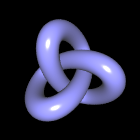Now for squares: back in the early 20th century some folks puzzled over whether it was possible to disect a square into smaller squares, each a different size. An easier problem would be to disect a rectangle into unequal squares. Fairly early on, in fact it was in the year 1903, the same year my parents were born, Max Dehn proved that it sufficed for the squares to have whole numbers for the lengths of their edges. Then in 1925 a fellow named Moron (OK not quite, make that Zbigniew Moroń(1904-1971)) came along and found a solution for the almost square rectangle of dimensions 32 by 33. Nowadays it is known that there are infinitely many different almost square rectangles (length minus width equals 1) which can dissected into unequal squares. Moroń's 33 by 32 example was the basis of a ceramic tile I built a few years ago. Here is a photo of it:
For a while it was suspected that such a dissection was impossible for a square. But in 1939 R. Sprague published the first example of a 'squared square' as such things came to be called. At nearly the same time, in the years 1936-8, four youngsters, then undergraduates at Trinity College, Cambridge became nearly obsessed with this problem. They found squared squares and developed a whole theory involving electrical networks for working with this and related problems, eventually published as: The dissection of rectangles into squares. R. L. Brooks, C. A. B. Smith, A. H. Stone and W. T. Tutte. Source: Duke Math. J. Volume 7, Number 1 (1940). These youngsters all went on to be well known in mathematics-related fields. A more thorough discussion of all this can be found here.
The examples of squared squares at this time were far from the simplest, and no one knew what the simplest example would be. Finally the simplest, a dissection of a square into 21 unequal squares, was found in March 1978 by AJW Duijvestijn, published as 'Simple perfect squared square of lowest order', J. Combin. Theory Ser. B 25 (1978), no. 2, 240-243. You can see a colored picture of it in my previous blog post called Hommage à A.J.W. Duijvestijn.
Recently I found and tried out some free recursive postscript software and made this image based on Duijvestijn's order 21 squared square:
OK, enough about squares. Now a tiny bit about wallpaper. Wallpaper often contains repeating patterns and mathematicians have studied these and determined that every repeating wallpaper pattern belongs to one of 17 possible types. To see examples of these 17 different types and much more information just click here. I just wanted to share a wallpaper pattern I recently created with free software called 'kali' which has been available on the internet at least since 1995. Here is my image, now on flickr (a larger version is here):


No comments:
Post a Comment